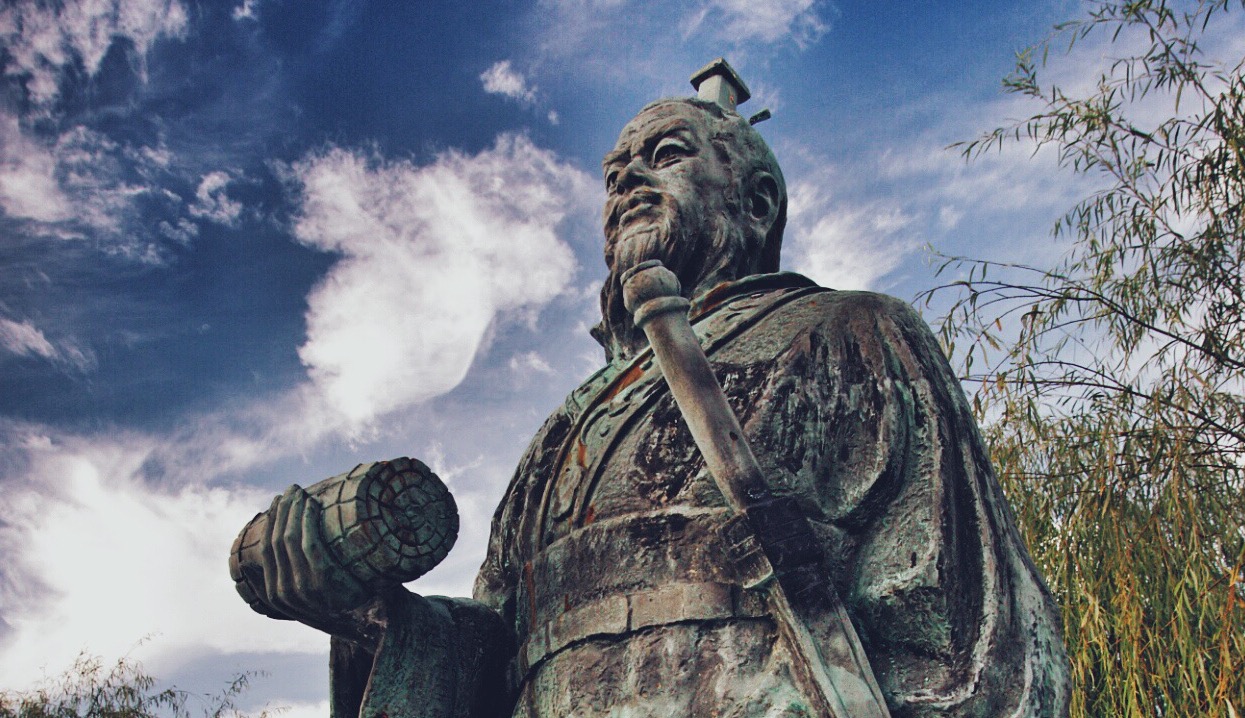EXECUTIVE SUMMARY: Although nuclear strategy must, by definition, be shaped without historical precedent, it should contain certain ancient core concepts. The strategic postulates first laid down by Sun Tzu could be referenced usefully by the current architects of US nuclear strategy, especially with reference to an already nuclear North Korea, and to a plausibly future nuclear adversary in Iran. These first principles could be applied to US ally Israel, in consequence of their direct impact on US policies, and to ongoing North Korean military activity in Syria or the wider Middle East.
Ancient Chinese general and military strategist Sun Tzu’s The Art of War should be studied by US President Donald Trump’s senior military advisors. Their examination of the text ought to focus on maximizing the credible range of America’s nuclear deterrent and on shaping the Pentagon’s correlative order of battle.
Any nuclear war would obviously be unprecedented. The August 1945 US bombings of Japan were not instances of nuclear war, but rather singular and non-replicable atomic attacks in a conventional war. Because there has never been an actual nuclear war, nothing can reliably be said about determining such a conflict’s probability. In science and mathematics, proper assessments of event probability must be based upon the determinable frequency of relevant past events.
President Trump could learn from Sun Tzu’s “Tao of Warfare” that the military world, like the world in general, “is what it is.” Any contrived reduction in analytic complexity could result in a too risky distortion of strategic choices. To deal correctly with such inevitable complexity, what is needed is not attitude but preparation.
Ultimately, the US summit imbroglio with North Korea was about implementing necessary dissuasions from future war, conventional as well as nuclear.
Preventing a conventional conflict with Pyongyang is imperative not only because such an engagement could prove starkly injurious to US forces and nationals in South Korea and also to certain US regional allies, but because it could quickly escalate towards the nuclear threshold. Such an escalation could prove uncontrollable.
Whatever the results of the Singapore summit (a meeting that Donald Trump felt would be best managed through attitude rather than preparation), America’s general strategy will remain embedded in various forms of deterrence, including nuclear deterrence. Going forward, whatever the ultimate outcomes of the summit, this basic strategy must remain rooted in one or several of the following six national security functions:
- deterrence of large-scale conventional attacks by enemy states;
- deterrence of all levels of unconventional attack by enemy states;
- preemption of enemy-state nuclear attacks;
- support of conventional preemptions against enemy-state nuclear assets;
- support of conventional preemptions against enemy-state non-nuclear assets; and
- nuclear war-fighting.
At some point in the future, President Trump may need to leverage US nuclear weapons in order to support certain forms of American conventional preemption. To proceed rationally in any such uncharted strategic territory, he would first need to determine whether any non-nuclear expressions of “anticipatory self-defense” could succeed operationally. In turn, this vital determination would then depend upon a number of critical, interpenetrating and possibly synergistic security factors, including:
- expected probability of North Korean first-strikes;
- expected costs of North Korean first-strikes;
- expected schedule of North Korean nuclear weapons deployment;
- expected efficiencies of North Korean active defenses over time;
- expected efficiencies of US active defenses over time;
- expected efficiencies of US hard-target or “counterforce” operations over time;
- expected reactions of unaffected regional enemies; and
- expected US and world community reactions to any considered American preemptions.
“Weighing strength,” reminds Sun Tzu, “gives birth to victory.” But any such prescribed measurement is exceedingly difficult to detach from subjective calculation. This means an American president ought never to assume he harbors an incomparably great capacity to maintain full control over unfolding events.
For President Trump and his counselors, other connections will need to be examined. Several would concern relationships between nuclear threat functions, primarily deterrence, and pertinent binding law. Contrary to conventional wisdom on law and geopolitics, nuclear deterrence does not function outside the ambit of international law. Since the Peace of Westphalia in 1648, international law (however regrettably) has had to rely upon assorted threat system dynamics of threat and counter-threat.
This candid appraisal concerns even preemption, which can sometimes be construed as “anticipatory self-defense” under customary international law.
This judgment of legal correctness includes an 8 July 1996 advisory decision of the International Court of Justice. The summary assessment concludes, “…in view of the current state of international law, and of the elements of fact at its disposal, the Court cannot conclude definitively whether the threat or use of nuclear eapons would be lawful or unlawful in an extreme circumstance of self-defense, in which the very survival of a State would be at stake.”
In some respects, at least, this ICJ Advisory Opinion should concern US ally Israel even more urgently than the US directly. After all, nuclear deterrence, whether ambiguous or openly declared, remains indispensable to Israel’s core survival needs.
The adequacy of international law in preventing both nuclear and conventional war in Northeast Asia – a war that could conceivably “spill over” to other regions, plausibly the Middle East – will depend upon more than formal treaties, customs, or the so-called “general principles of law recognized by civilized nations.” Among other perils, North Korea has continued to send advanced weapons to Syria, including outlawed chemical weapons, thereby strengthening not only the openly criminal Damascus regime, but also the Shiite terrorist group Hezbollah, as well as Iran. The injurious consequences of any such arms transfers could be most consequential for Israel as it seeks to prepare for an expanding Iranian military presence within Syria. It will also be contingent upon the success or failure of any competing US and North Korean military strategies in the region.
If President Trump’s selected nuclear strategy should serve to reduce the threat and/or seriousness of future war, either because of successfully implemented forms of nuclear deterrence or because of “no alternative” preemptive strikes launched against an illegally nuclearizing North Korea, this strategy could be counted as an authentic component of international law enforcement.
How should Washington proceed? Initially, President Trump would do well to consider Sun Tzu’s principles concerning diplomacy. To be sure, suitable military preparations should never be neglected, but diplomacy must also preserve its place. By fusing power and diplomacy, says Sun Tzu, the objective of every state to weaken its enemies without engaging in armed combat can better be realized.
Sun Tzu’s overriding objective always links the ideal of complete victory to reciprocal strategies for planning offensives.
Today, this advice may seem obvious enough, yet current US strategic posture will depend heavily upon various forms of ballistic missile defense (BMD). In principle, at least, by placing too much faith in its active defense systems, the US could become willing to accept certain excessive risks, and also to disavow any still remaining preemption options.
There is really no good reason to believe that the US nuclear deterrent could ever suitably reduce all conceivable nuclear threats from North Korea. In spite of America’s advanced deterrent postures, there could still come a time when the power of Washington’s implicit nuclear threat would be immobilized by enemy miscalculation, inadvertence, mechanical accident, false warnings, unauthorized firings (e.g., coups d’état), hacking, or even outright irrationality. Furthermore, a calculated US willingness to make such threats more conspicuous need not necessarily be matched by any greater likelihood of operational success.
Assuming operational rationality in the White House and in the Pentagon, the single most compelling factor in any US presidential decision on preemption against North Korea will likely be the perceived rationality of Kim Jung-un. If, after all, Kim were expected to strike at America or certain US allies with nuclear weapons irrespective of any anticipated US counterstrikes, American deterrence could fail altogether. This means that North Korean nuclear strikes could be expected even if Kim Jung-un had already understood that President Trump was willing and able to respond to Pyongyang’s aggressions with devastating nuclear reprisals.
Any North Korean decision to strike in these circumstances would have been made in spite of US deployment of nuclear weapons in recognizably survivable modes, and in spite of the fact that those American rockets and bombs were able to penetrate North Korea’s most sophisticated, effective, and widespread active defenses.
Some might argue, more or less persuasively, that the US has already lost any preemption option it once had with respect to North Korean nuclear weapons. As a result of enemy multiplication, dispersal, and hardening of infrastructures, goes this argument, President Trump can now only wait until the time comes for an after-the-fact response; that is, for inflicting punishment or retaliation. If this purely retributive argument is correct, any such total US reliance upon deterrence and certain corollary active defenses could represent a fatal indifference to enduring general principles of classic Chinese military strategy.
Another section of The Art of War that could help President Trump compensate for any disproportionate reliance on nuclear deterrence and ballistic missile defense is the one in which Sun Tzu emphasizes the “unorthodox.” Drawn from the school of thought that had crystallized as Taoism, the ancient strategist observes: “…in battle, one engages with the orthodox, and gains victory through the unorthodox.”
In another complex passage, Sun Tzu discusses how the orthodox may be used in unorthodox ways, while an orthodox attack may still be unorthodox, at least when it is unexpected. Taken with appropriate seriousness by American strategic planners, this nuanced passage could prove a useful tool for meaningful tactical implementation, one that might exploit Kim Jung-un’s presumed matrix of identifiable military objectives.
For President Trump, the “unorthodox” should be fashioned not only on the battlefield but also before the battle. To prevent the most dangerous forms of battle, or those military engagements that could subsequently descend into allout unconventional warfare, Washington should fashion a number of new military postures. These advanced postures would focus on a reasoned shift from “orthodox” rationality to “unorthodox” irrationality. This sort of thinking is what the late American nuclear strategist Herman Kahn had earlier called the “rationality of pretended irrationality.”
On several occasions, President Trump has demonstrated a quirky affection for postures of feigned irrationality. Such calculated pretense has to be performed with considerable finesse, however, to avoid its becoming a double-edged sword. Also worth noting is that any strategy of pretended irrationality would represent the diametric opposite of Sun Tzu’s more general counsel. In Chapter One, entitled “Initial Estimations,” he remarks that military success must always be based upon “rationality and self-control.”
President Trump requires a pattern of thinking adapted not only by Sun Tzu, but also by some of his classic contemporaries in ancient Greece. To create a nuclear doctrine, he will need to fashion a genuinely usable “strategic dialectic.” Any such interrogative method would ask and answer intersecting questions, sequentially, again and again, until all core security problems had been productively confronted head-on.
Following Sun Tzu’s prescriptions on the “unorthodox,” US strategists should approach the challenging North Korea security problem as an interrelated series of thoughts, one in which each thought necessarily presents a complication that then moves inquiry onward. Contained in this strategic dialectic, as Sun Tzu himself was no doubt aware, is a relentless obligation to continue thinking. (Logically, this imperative can never be satisfied entirely because of what philosophers call an “infinite regress problem,” but it must be attempted as completely and competently as possible.)
Armed with such an explicitly dialectical form of military strategy, Trump could then focus not only on discrete threats and situations (most plausibly, North Korean nuclear weapons and ballistic missile development), but also on multiple dynamic interactions between particular threats (“synergies”.)
Sun Tzu can offer Trump the still timely wisdom that strategy and war planning are fundamentally intellectual activities.
Especially because Kim Jung-un already commands a nuclear arsenal, one he will most assuredly refuse to destroy, America’s emphasis must be on using its combined military assets to create stable deterrence rather than to wage war. “Subjugating the enemy’s army without fighting,” says Sun Tzu in The Art of War, “is the true pinnacle of excellence.”
The ancient Chinese strategist also devotes a good deal of attention to the necessary “ruler’s qualifications.”
From this listing, Trump could be reminded that “The ruler cannot mobilize the army out of any personal anger.” He could also learn the following leadership strengths: wisdom; knowledge; benevolence; unconcern for fame; tranquility; and righteousness. Correspondingly, leaders’ weaknesses can include: obsession with achieving fame; quickness to anger; haste to act; inability to fathom the enemy; and personal arrogance.
In complex military affairs, generality is an indispensable trait of explanatory and predictive meaning. Strategic theory represents an important net with which both planners and policy-makers can catch whatever is most vital. To think otherwise, or to approach every major military crisis as somehow analytically discrete or ad hoc, would represent nothing less than a form of national surrender.
To avoid such a surrender, it would profit President Trump to heed the timeless strategic principles of Sun Tzu.


























